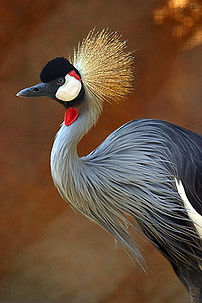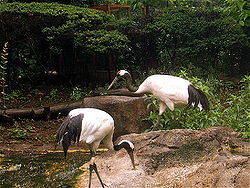Crane (bird)
| Cranes | ||||||||||
|---|---|---|---|---|---|---|---|---|---|---|
 Indian Sarus Crane
Gruzs antigone antigone | ||||||||||
| Scientific classification | ||||||||||
| ||||||||||
|
In botany, a crane is any of the large, long-legged, long-necked, wading birds comprising the family Guidae of the order Gruiformes. They are similar in appearance to some species of the unrelated herons, but, among other differences, cranes fly with necks outstretched (and stiltlike legs trailing behind), whereas herons fly with their necks retracted.
There are 15 extant species of cranes. There are representatives of this group on all the continents except Antarctica and South America.
Most species of cranes are at least threatened, if not critically endangered, within their range. The plight of the Whooping Cranes of North America inspired some of the first US legislation to protect endangered species.
Description
Cranes have a long bill, long neck, and long legs. They are wading birds like the herons that they resemble, but the herons are placed in the Ardeidae family of the Ciconiiformes order. Traditionally, Ciconiiformes has included a variety of large, long-legged wading birds with large bills: storks, herons, egrets, ibises, spoonbills, and several others. The cranes belong to the Guidae family of the order Gruiformes, an order that includes rails, limpkins, finfoots, and trumpeters. Altough the cranes seem similar to the herons, anatomical evidence, as well as recent molecular evidence, supports the closer relationship to the rails and so forth of Gruiformes.
Cranes tend to be larger than herons and with a heaver bill and elevated hind toe. In addition, as noted above, herons tend to fly with their necks retracted, not outstretched like the crane.
They are opportunistic feeders that change their diet according to the season and their own nutrient requirements. They eat a range of items from suitably sized small rodents, fish, amphibians, and insects, to grain, berries, and plants. (The cranberry is so-named for its flowers' resemblance to the neck and head of the crane.)
Most cranes have elaborate and noisy courting displays or "dances". While folklore often states that cranes mate for life, recent scientific research indicates that these birds do change mates over the course of their (considerable) lifetimes (Hayes 2005). Some species and/or populations of cranes migrate over long distances, while some do not migrate at all. Cranes are gregarious, forming large flocks where their numbers are sufficient.
Systematics
There are 15 living species of cranes in 4 genera:
SUBFAMILY BALEARICINAE - crowned cranes
- Genus Balearica
- Black Crowned Crane, Balearica pavonina
- Grey Crowned Crane, Balearica regulorum
SUBFAMILY GRUINAE - typical cranes
- Genus Grus
- Common Crane, Grus grus, also known as the Eurasian Crane
- Sandhill Crane, Grus canadensis
- Whooping Crane, Grus americana
- Sarus Crane, Grus antigone
- Brolga, Grus rubicunda
- Siberian Crane, Grus leucogeranus
- White-naped Crane, Grus vipio
- Hooded Crane, Grus monacha
- Black-necked Crane, Grus nigricollis
- Red-crowned Crane, Grus japonensis
- Genus Anthropoides
- Blue Crane, Anthropoides paradisea
- Demoiselle Crane, Anthropoides virgo
- Genus Bugeranus
- Wattled Crane, Bugeranus carunculatus
The fossil record of cranes leaves much to be desired. Apparently, the subfamilies were well distinct by the Late Eocene (around 35 mya). The present genera are apparently some 20 mya old. Biogeography of known fossil and the living taxa of cranes suggests that the group is probably of (Laurasian?) Old World origin. The extant diversity at the genus level is centered on (eastern) Africa, making it all the more regrettable that no decent fossil record exists from there. On the other hand, it is peculiar that numerous fossils of Ciconiiformes are documented from there; these birds presumably shared much of their habitat with cranes back then already.
Fossil genera are tentatively assigned to the present-day subfamilies:
Balearicinae
- Geranopsis (Hordwell Late Eocene - Early Oligocene of England)
Gruinae
- Palaeogrus (Middle Eocene of Germany and Italy - Middle Miocene of France)
- Pliogrus (Early Pliocene of Eppelsheim, Germany)
- Camusia (Late Miocene of Menorca, Mediterranean)
- "Grus" conferta (Late Miocene/Early Pliocene of Contra Costa County, USA) - see Miller & Sibley (1942)
Sometimes considered Gruidae
- Eobalearica (Ferghana Late? Eocene of Ferghana, Uzbekistan)
- Probalearica (Late Oligocene? - Middle Pliocene of Florida, USA, France?, Moldavia and Mongolia) - A nomen dubium?
- Aramornis (Sheep Creek Middle Miocene of Snake Creek Quarries, USA)
The supposed Grus prentici is not a true crane; it was eventually placed in the genus Paragrus (Lambrecht 1933:520).
Cranes in popular culture
- In Fox's TV series Prison Break, the protagonist (Michael Scofield) leaves paper folded cranes at important places in his attempt to arrange escape from prison for himself and his older brother (Lincoln Burrows). Late in the first season it becomes clear that Lincoln used to leave paper cranes by Michael's bedside when they were kids, and that the crane supposedly stands for 'a familial obligation' and 'watching out for your own'.
- On The Future Is Wild, a large bird known as the great blue windrunner is a fictional descendant of cranes.
- On The Decemberists CD The Crane Wife, they have 2 songs creating a story about a crane wife.
In the (1939) movie The Wizard of Oz, a bizarre rumor that one of the Munchkins hanged himself in the forest set is easily disproved by close inspection of the scene. The supposed body, swinging from a tree branch in the forest set, is actually a live crane in the background. It can be seen as the characters exit the forest near the Tin Man's cottage.
Myth and lore
The cranes' beauty and their spectacular mating dances have made them highly symbolic birds in many cultures with records dating back to ancient times. Crane mythology is widely spread and can be found in areas such as the Aegean, South Arabia, China, Japan and in the Native American cultures of North America. In northern Hokkaidō, the women of the Ainu people, whose culture is more Siberian than Japanese, performed a crane dance that was captured in 1908 in a photograph by Arnold Genthe. In Korea, a crane dance has been performed in the courtyard of the Tongdosa Temple since the Silla Dynasty (646 C.E.).
In Mecca, in pre-Islamic South Arabia, the goddesses Allat, Uzza, and Manah, who were believed to be daughters of and intercessors with Allah, were called the "three exalted cranes" (gharaniq, an obscure word on which 'crane' is the usual gloss). See The Satanic Verses for the best-known story regarding these three goddesses.
The Greek for crane is Γερανος (Geranos), which gives us the Cranesbill, or hardy geranium. The crane was a bird of omen. In the tale of Ibycus and the cranes, a thief attacked Ibycus (a poet of the 6th century B.C.E.) and left him for dead. Ibycus called to a flock of passing cranes, who followed the murderer to a theater and hovered over him until, stricken with guilt, he confessed to the crime.
Pliny the Elder wrote that cranes would appoint one of their number to stand guard while they slept. The sentry would hold a stone in its claw, so that if it fell asleep it would drop the stone and waken.
Aristotle describes the migration of cranes in The History of Animals, adding an account of their fights with Pygmies as they wintered near the source of the Nile. He describes as untruthful an account that the crane carries a touchstone inside it that can be used to test for gold when vomited up. (This second story is not altogether implausible, as cranes might ingest appropriate gizzard stones in one locality and regurgitate them in a region where such stone is otherwise scarce)
Also, the word "pedigree" comes from the Old French phrase, "pie de grue", which means "foot of a crane", as the pedigree diagram looks similar to the branches coming out of a crane's foot.
A crane is considered auspicious in China, Japan and Vietnam. It is one of the symbols of longevity and is often represented with other symbols of long life, such as pine, bamboo, and the tortoise. Vietnamese people consider crane and dragon to be symbols of their culture. In feudal Japan the crane was protected by the ruling classes and fed by the peasants. When the feudal system was abolished in the Meiji era of the 19th century, the protection of cranes was lost. With effort they have been brought back from the brink of extinction. Japan has named one of their satellites tsuru (crane, the bird). According to tradition, if one folds 1000 origami cranes one's wish for health will be granted. Since the death of Sadako Sasaki this applies to a wish for peace as well.
Also, traditional Chinese 'heavenly cranes' (tian-he) or 'blessed cranes' (xian-he) were messengers of wisdom. Legendary Taoist sages were transported between heavenly worlds on the backs of cranes.
See also
- International Crane Foundation
ReferencesISBN links support NWE through referral fees
- Hayes, M.A. (2005): Divorce and extra-pair paternity as alternative mating strategies in monogamous sandhill cranes. MS thesis, University of South Dakota, Vermilion, S.D.. 86 p. PDF fulltext at the International Crane Foundation's Library
- Lambrecht, Kálmán (1933): Handbuch der Palaeornithologie. Gebrüder Bornträger, Berlin.
- Miller, Alden H. & Sibley, Charles G. (1942): A New Species of Crane from the Pliocene of California. Condor 44: 126-127. PDF fulltext
External links
- Saving Cranes website (ICF)
- Craneworld website
- Gruidae videos on the Internet Bird Collection
- Origami crane
Myth and Lore links
- Crane mythologies. Not selective, a starting point
- Crane Dance at the Tongdosa Temple (archive link, was dead)
- Thousand Cranes lore.
Credits
New World Encyclopedia writers and editors rewrote and completed the Wikipedia article in accordance with New World Encyclopedia standards. This article abides by terms of the Creative Commons CC-by-sa 3.0 License (CC-by-sa), which may be used and disseminated with proper attribution. Credit is due under the terms of this license that can reference both the New World Encyclopedia contributors and the selfless volunteer contributors of the Wikimedia Foundation. To cite this article click here for a list of acceptable citing formats.The history of earlier contributions by wikipedians is accessible to researchers here:
The history of this article since it was imported to New World Encyclopedia:
Note: Some restrictions may apply to use of individual images which are separately licensed.

